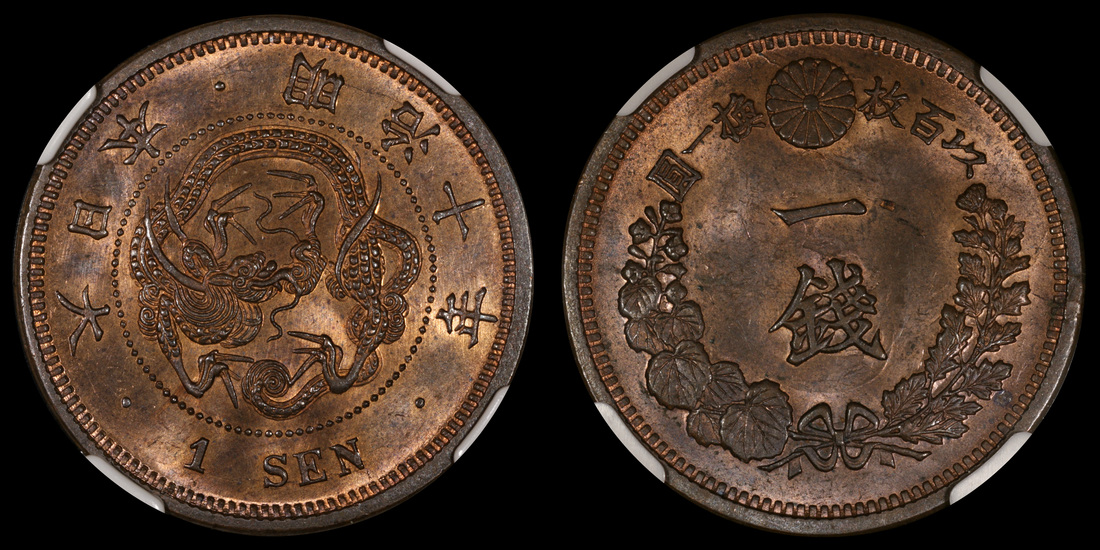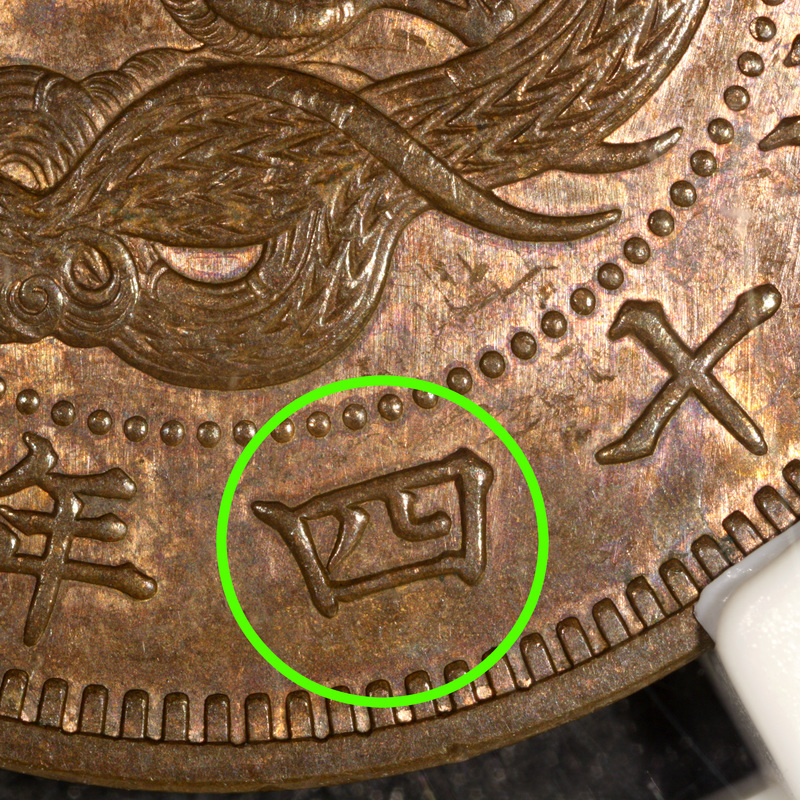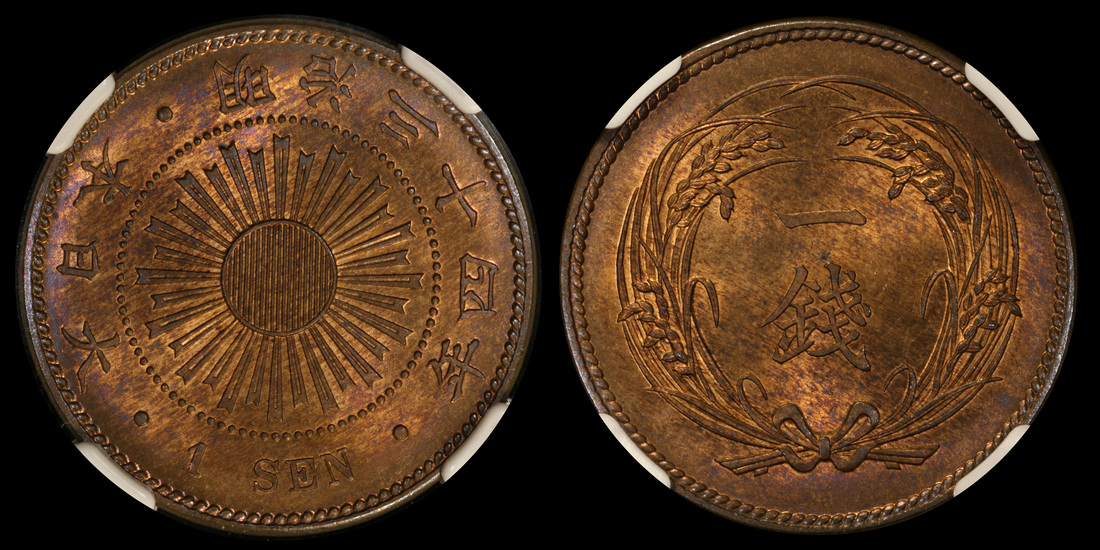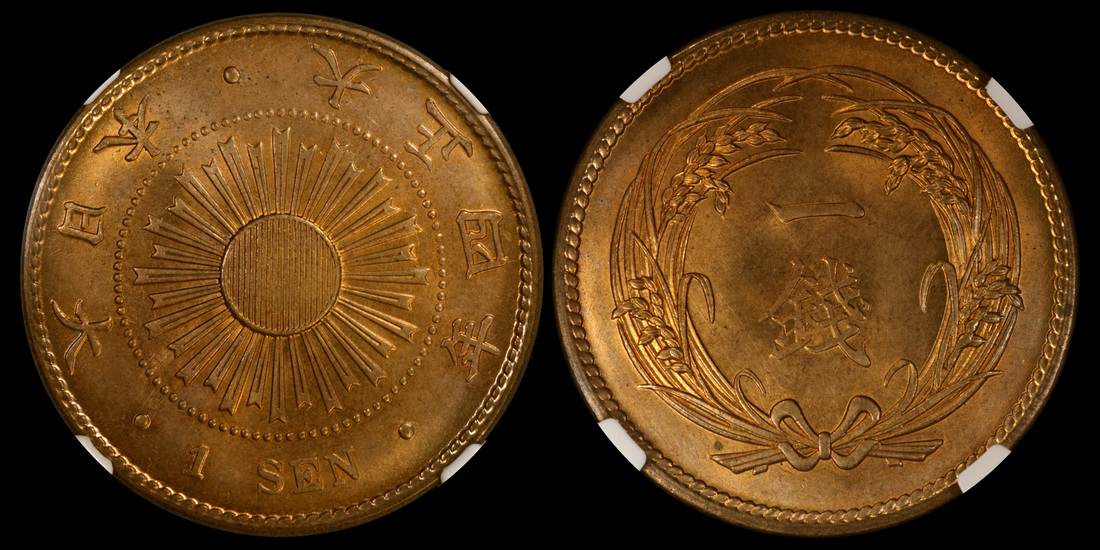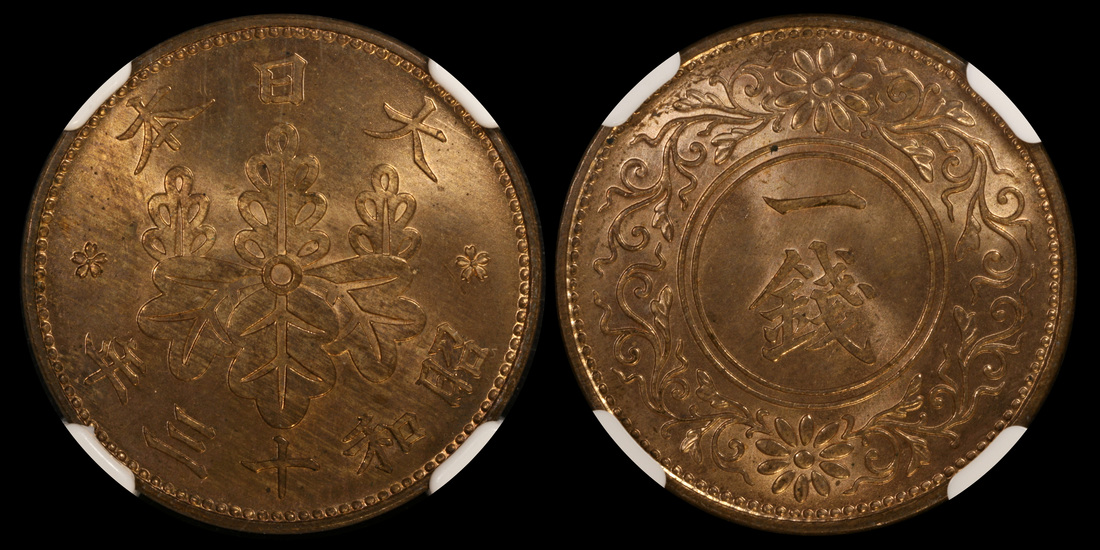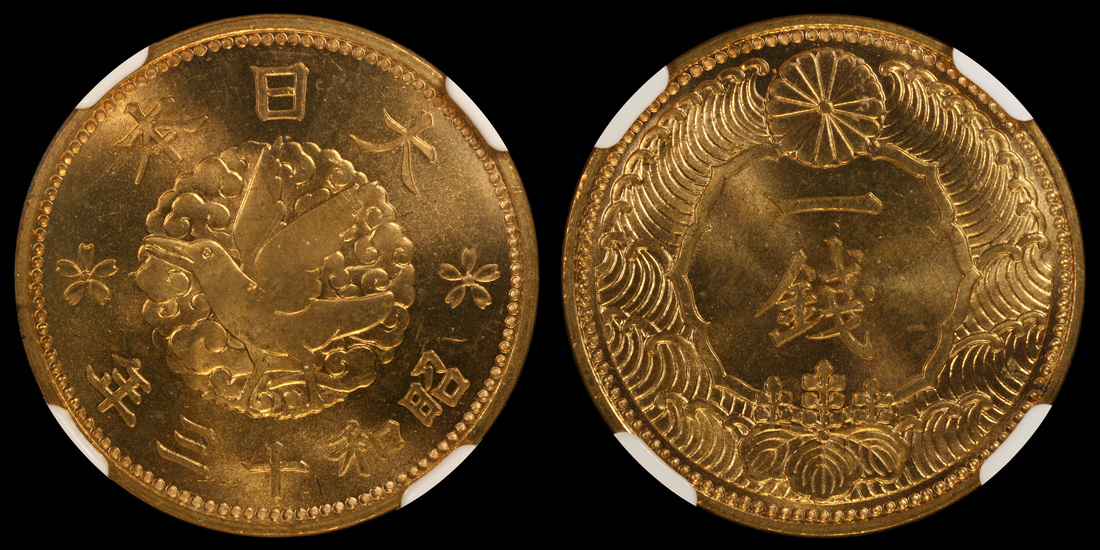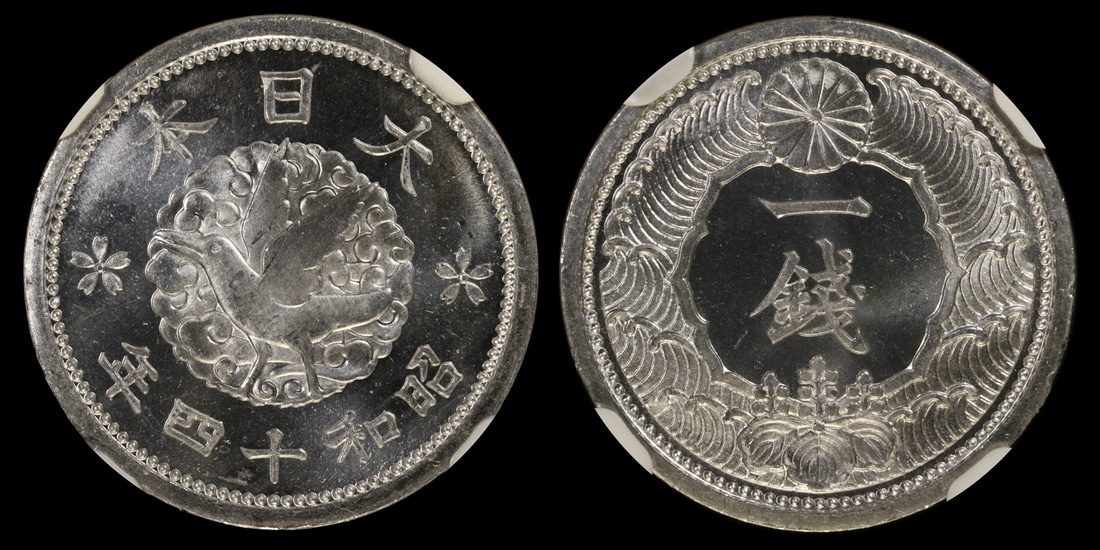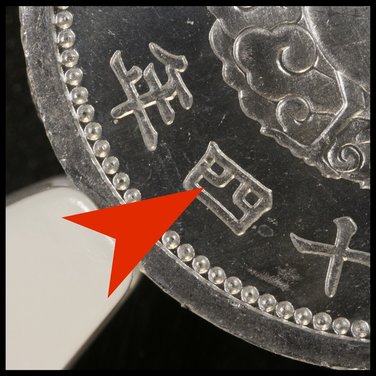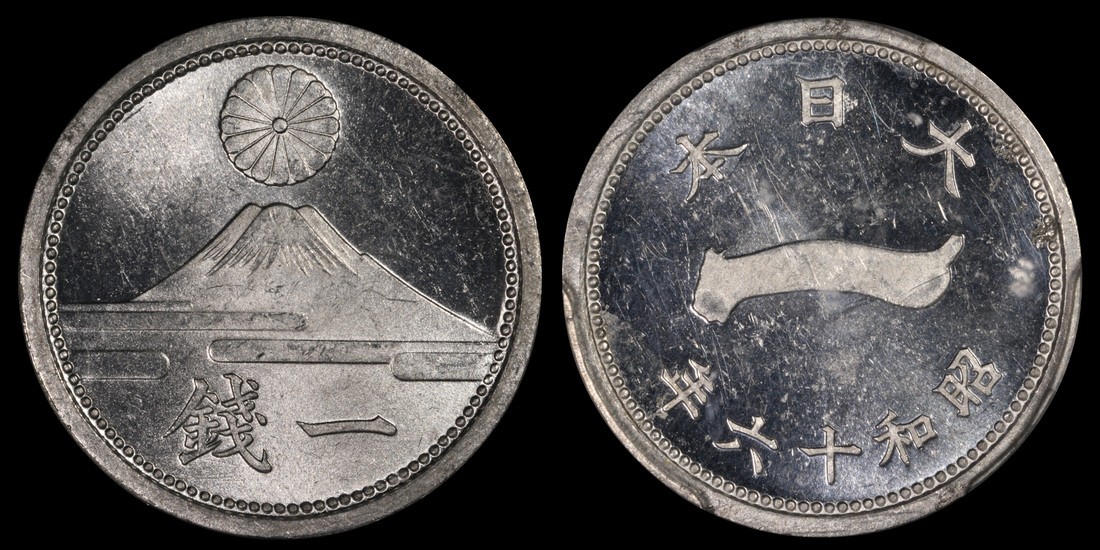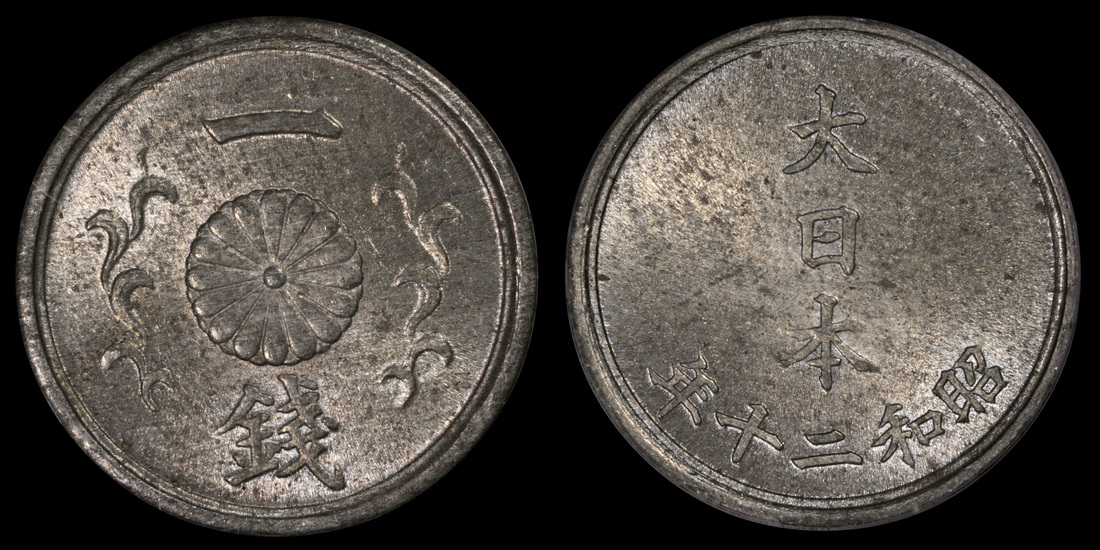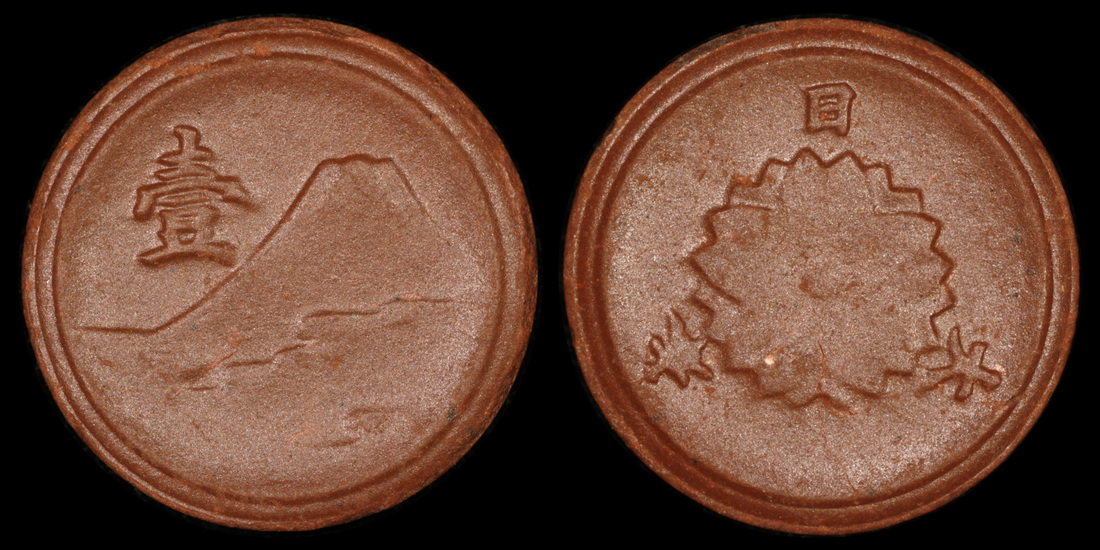Japan, 1870-1950SEN
|
The sen is 1/100 of the yen. It was among the first coins minted, and continued as late as 1945--though not minted in every year. Thereafter the current monetary system was in place and the yen became the smallest circulating denomination.
The following series show the progression of the sen from the first through the last types produced. Also noted are the JNDA catalog numbers and associated information.
The following series show the progression of the sen from the first through the last types produced. Also noted are the JNDA catalog numbers and associated information.
JNDA 01-46. Like the half sen, the first full sen design was minted non-continuously from M6 (1873) through M21 (1888).
Also the initial design featured two obverse styles, with the earlier type having a dragon with 'squared' appearing dragon scales and the later issues with a 'sharp' scale style. Unlike the 1/2 sen there was not an overlap in the design within a single year. The reverse has the standard tied foliage branches, centered denomination and the Imperial Chrysanthemum crest seen in the earlier coinage. The inscription across the top of the reverse translates to "100 pieces in exchange for 1 yen'.
Copper alloy. Diameter 27.87 mm. Weight 7.13 grams.
Also the initial design featured two obverse styles, with the earlier type having a dragon with 'squared' appearing dragon scales and the later issues with a 'sharp' scale style. Unlike the 1/2 sen there was not an overlap in the design within a single year. The reverse has the standard tied foliage branches, centered denomination and the Imperial Chrysanthemum crest seen in the earlier coinage. The inscription across the top of the reverse translates to "100 pieces in exchange for 1 yen'.
Copper alloy. Diameter 27.87 mm. Weight 7.13 grams.
|
This coin is also an example of the 'small 4' variety. I do not yet have a 'large 4' for comparing.
Basically, the 'small 4' is not only smaller, but the inner strokes of the normal '4' symbol (四) are similar to the katakana 'ru' character (ル). The 'large 4' has the inner strokes akin to Chinese lettering, and actually looks more like a 'hachi' or 8 (ハ). |
JNDA 01-47. After a 10 year hiatus the 1 sen denomination returned combining the Rising Sun obverse and a rice stalk wreath/denomination reverse, and have shifted from copper to a bronze alloy while otherwise retaining size/weight of the preceding sen coin. The coins were minted in both the Meiji and Taisho eras, and fall under the same JNDA number.
Bronze. Diameter 27.87 mm. Weight 7.13 grams.
Bronze. Diameter 27.87 mm. Weight 7.13 grams.
JNDA 01-48. The Paulownia sen was minted non-continuously from Taisho 5 through Showa 13. The obverse features the issuing authority (Dai Nippon or Great Japan) with the paulownia leaf and the date below. The reverse has the denomination and a stylized scrolling design.
Bronze alloy. Diameter 23.03 mm. Weight 3.75 grams.
Bronze alloy. Diameter 23.03 mm. Weight 3.75 grams.
JNDA 01-49. The obverse features a crow while the reverse has the chrysanthemum design (Imperial Crest) at the top, with a wave pattern around the border. At the bottom is a paulownia leaf design (representing the government).
Bronze alloy. Diameter 23.03, brass. Weight 3.75 grams.
Bronze alloy. Diameter 23.03, brass. Weight 3.75 grams.
JNDA 01-50. The design mimics the second type of 1 sen, with the crow obverse/chrysanthemum-waves-paulownia reverse of the previous brass type. This type was only minted for three years.
Aluminum. Diameter 17.6 mm. Weight .9 grams.
Aluminum. Diameter 17.6 mm. Weight .9 grams.
1939 is of particular interest given the two varieties of the four character ( 四 ) as depicted in the following pictures. The scarcer variety is Type A, the so-called 'angled stroke' seen in the picture below to the left. The more common variety is Type B, with the uniform or flat stroke as seen in the photo to the right (and is the coin pictured above as well). NGC does not appear to attribute this variety, but PCGS does.
The Type A/angled example in the following picture is a PCGS MS-66 graded coin.
The Type A/angled example in the following picture is a PCGS MS-66 graded coin.
JNDA 01-51. The obverse is a simple design with the issuing authority, date and a large '1' character. The reverse shows Fuji-san with the Imperial Chrysanthemum above and the denomination below.
Aluminum. Diameter 16 mm. Weight .65 grams, reduced to .55 grams during the last year (both weights produced).
Aluminum. Diameter 16 mm. Weight .65 grams, reduced to .55 grams during the last year (both weights produced).
|
Showa 16 (1941) - Showa 18 (1943).
A wartime issue, this small coin was part of the progression in minimizing metal content that could be diverted to the war efforts. Minted for three years. In the last year there was a further reduction in weight in the later part of the year. |
JNDA 01-52. The final metal based 1 sen coin produced. It has a simple design with the obverse shows the issuing authority arranged vertically and the date along the bottom. The reverse has a central chrysanthemum crest dividing the denomination vertically and with sprigs around.
Tin-zinc alloy. Diameter 15 mm. Weight 1.3 grams.
Tin-zinc alloy. Diameter 15 mm. Weight 1.3 grams.
|
Minted 2 years, in Showa 19 (1944) and Showa 20 (1945).
Minted in the waning part of the war, the coin was produced from planchets of a tin-zinc alloy (though listed as just tin in the JNDA). This is a very reactive alloy and finding these in good condition can be challenging. |
The last sen pictured below was produced for circulation but never released. It is listed in the Krause catalogs and slabbed by the third party graders as a regular issue, but in the JNDA falls under the 'pattern' section. As such it does not have an individual JNDA number, but this particular coin (Fuji-san/blossom style) is listed.
The other denominations and designs are not listed in the JNDA, but are known--and can likely be called 'unlisted patterns' (or are documented in other references I don't have copies of). The clay/porcelain can be found in shades of red, brown and even white, and can feature other design motifs.
Reddish-brown porcelain (clay). Diameter 15 mm. Weight n/a.
The other denominations and designs are not listed in the JNDA, but are known--and can likely be called 'unlisted patterns' (or are documented in other references I don't have copies of). The clay/porcelain can be found in shades of red, brown and even white, and can feature other design motifs.
Reddish-brown porcelain (clay). Diameter 15 mm. Weight n/a.

